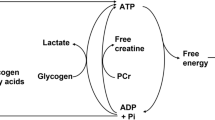Abstract
The role of central command in the respiratory response to 15 min of rhythmic-static (isometric) exercise was studied in humans. Voluntary exercise (VE) was compared with electrically induced exercise (EE) at three different work intensities, i.e. 5%, 15% and 25% of maximal voluntary contraction. A group of 12 volunteers participated in the study and each of them performed six sessions. A session consisted of at least 5 min rest, 15 min rhythmic-static single leg exercise (4 s contraction/12 s relaxation) and at least 5 min recovery. Force, minute ventilation (V E) and oxygen uptake (VO2) were measured. In EE, both V E and VO2 increased continuously during the entire exercise period after an initial rapid increase at all three work intensities. Correlation between VE and VO2 was highly significant during EE. During all three work intensities of VE, VE and VO2 achieved a steady-state after the initial increase. During VE, VE did not correlate as closely with VO2 as during EE. All these findings indicate that central command was not imperative for an adequate ventilatory response to exercise within all three work intensities investigated. Without the influence of central command, correlation between VE and VO2 was even better than during VE.
Similar content being viewed by others
References
Adams L, Garlick J, Guz A, Murphy K, Semple SJG (1984) Is the voluntary control of exercise in man necessary for the ventilatory response? J Physiol (Lond) 355:71–83
Adams L, Guz A, Innes JA, Murphy K (1987) The early circulatory and ventilatory response to voluntary and electrically induced exercise in man. J Physiol (Lond) 383:19–30
Asmussen E, Nielsen M, Wieth-Pedersen G (1943) Cortical or reflex control of respiration during muscular work. Acta Physiol Scand 6:168–175
Asmussen E, Johansen SH, Jørgensen M, Nielsen M (1965) On the nervous factors controlling respiration and circulation during exercise. Acta Physiol Scand 63:343–350
Banner N, Guz A, Heaton R, Innes JA, Murphy K, Yacoub M (1988) Ventilatory and circulatory responses at the onset of exercise in man following heart or heart-lung transplantation. J Physiol (Lond) 399:437–449
Benton LA, Baker LL, Bowman BR, Waters RL (1983) Funktionelle Elektrostimulation. Ein Leitfaden für die Praxis. Steinkopff, Darmstadt
Boutellier U, Kündig T, Gomez U, Pietsch P, Koller EA (1987) Respiratory phase detection and delay determination for breath-by-breath analysis. J Appl Physiol 62:837–843
Boutellier U, Büchel R, Kundert A, Spengler C (1992) The respiratory system as an exercise limiting factor in normal trained subjects. Eur J Appl Physiol 65:347–353
Brice AG, Forster HV, Pan LG, Funahashi A, Lowry TF, Murphy CL, Hoffman MD (1988) Ventilatory and PaCO2 responses to voluntary and electrically induced leg exercise. J Appl Physiol 64:218–225
Concu A (1988) Respiratory and cardiac effects of passive limb movements in man. Pflügers Arch 412:548–550
Concu A (1989) Contribution of central and reflex nervous activity to the rapid increase in pulmonary ventilation at the start of muscular exercise in man. Eur J Appl Physiol 59:10–15
Dejours P (1964) Control of respiration in muscular exercise. In: Fenn WO, Rahn A (eds) Handbook of physiology. Respiration. Waverly Press, Baltimore, pp 631–648
Eldridge FL, Millhorn DE, Kiley JP, Waldrop TG (1985) Stimulation by central command of locomotion, respiration and circulation during exercise. Respir Physiol 59:313–337
Enoka RM (1988) Muscle strength and its development. Sports Med 6:146–168
Fernandes A, Galbo H, Kjaer M, Mitchell JH (1990) Cardiovascular and ventilatory responses to dynamic exercise during epidural anaesthesia in man. J Physiol (Lond) 420:281–293
Galster JV, Spörl G (1986) Erlanger Angst Skala. Internationale Skalen für Psychiatric. Beltz Test, Weinheim
Innes JA, De Cort SC, Evans PJ, Guz A (1992) Central command influences cardiorespiratory response to dynamic exercise in humans with unilateral weakness. J Physiol (Lond) 448:551–563
Krogh A, Lindhard J (1913) The regulation of respiration and circulation during the initial stages of muscular work. J Physiol (Lond) 47:112–136
Mador MJ, Acevedo FA (1991) Effect of respiratory muscle fatigue on breathing pattern during incremental exercise. Am Rev Respir Dis 143:462–468
Mador MJ, Tobin MJ (1991) Effect of alterations in mental activity on the breathing pattern in healthy subjects. Am Rev Respir Dis 144:481–487
Ochwadt B, Bücherl E, Kreuzer H, Loeschcke HH (1959) Beeinflussung der Atemsteigerung bei Muskelarbeit durch partiellen neuromuskulären Block (Tubocurarin). Pflügers Arch 269:613–621
Pietsch P (1984) Das rechnerunterstützte Atmungsanalysesystem des Physiologischen Instituts Zürich. Thesis, University of Zurich, Zurich
Sachs L (1984) Angewandte Statistik: Anwendung statistischer Methoden, 6th edn. Springer, Berlin Heidelberg New York
Shepherd JT, Blomqvist CG, Lind AR, Mitchell JH, Saltin B (1981) Static (isometric) exercise. Retrospection and introspection. Circ Res 48 [Suppl 1]: 179–188
Author information
Authors and Affiliations
Rights and permissions
About this article
Cite this article
Spengler, C.M., von Ow, D. & Boutellier, U. The role of central command in ventilatory control during static exercise. Europ. J. Appl. Physiol. 68, 162–169 (1994). https://doi.org/10.1007/BF00244030
Accepted:
Issue Date:
DOI: https://doi.org/10.1007/BF00244030




